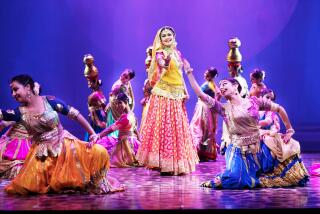INDIANS APPLAUD FESTIVALâS âTHE MAHABHARATAâ
Peter Brook and Jean-Claude Carriere make no apologies for not bringing India to the West in their nine-hour adaptation of âThe Mahabharata.â As Brook notes in the introduction to the newly published English translation, after making many trips to India and steeping themselves in the countryâs myriad performance traditions, the company âreturned from India knowing that our work was not to imitate but to suggest.â
Los Angeles-based Indians contacted by The Times not only think that was a wise decision on Brookâs part, but that, on the whole, the work is a success.
âIt felt like an Indian play to me,â said Mamti Bhattar, who works with her husband, Shashi, in the accounting department of the Los Angeles Theatre Center.
This thought raises a hard-to-resolve question: Is a work like âThe Mahabharata,â so thoroughly fundamental to Indian religion and culture, the property of India? Especially when one considers that âThe Bhagavad-Gita,â Krishnaâs reflections on war that preface the epicâs climactic battle, is the countryâs bible?
âNo,â said film director Jag Mundhra. âNo one owns âThe Mahabharata.â No person, no culture, can keep a work of art. I liked the fact that a British director was doing it, and casting it with an almost non-Indian, international group of actors. Seeing a completely new interpretation from what we were raised with is part of the excitement of art.â
Pratapaditya Pal, curator of Indian and Southeast Asian art for the Los Angeles County Museum of Art, was troubled, though, by part of Brooksâ multicultural strategy.
âIâm all for this internationalization of the cast. But if this production were taken to India (something Brook has said he eventually intends to do), it wouldnât be highly praised, because Indians cannot accept a white man (Bruce Myers) as Krishna (the god-man and earthly incarnation of the great god Vishnu, who possesses unlimited spiritual powers). Traditionally, heâs a very black-skinned figure.â
Pal also noticed that many Americans in the audience were surprised to see a very different, human Krishna than the one associated (âQuite negatively, understandably,â he added) with the Hare Krishna religious movement in this country.
The Westerners were also amused, Mundhra and Shashi Bhattar noted, at the markedly pre-feminist treatment of women in the play. âWhen Kunti (the mother of the epicâs five Pandava brothers) warns her sons to share their new wife (Draupadi) and make sure that she mustnât suffer in any way,â Bhattar remarked, âeveryone except we Indians laughed.
âTo us, this was no big thing. Besides, this kind of marriage no longer exists in India. I think this was an example of how the show cannot do the job of exposing Western audiences to Indian culture and traditions.â
Pal agreed, adding that âBrookâs project seems not to be one of transmission or even of education, but of fusing several theatrical styles continents apart.â
âPerhaps a more important influence here than Hindu drama is Japanese Noh theater, especially the gestures and the uncluttered, brilliantly simple scenic design.â
For Pal, the Bhattars and Mundhra, memories of village performances of what Shashi referred to as âThe Masterpieceâ flooded back as they sat recently in the bleachers of Raleigh Studios. âThis company obviously immersed (itself) in that tradition,â Mundhra said. âIn the villages, when Krishna appeared, villagers would go into devotional hysteria. That, of course, was missing this time. . . . â
Memories of a big-budget Indian movie version were more of a problem.
âThe third section (âWarâ) didnât succeed,â Mamti said, âbecause you simply canât show a battle on stage like you can in a movie. This is the war that destroys the world, but that didnât come across.â
Shashi: âThe movie linked various events together better than this new version. Yet Brook held my interest all the way, and that is a real tribute.â
Mundhra, a veteran of the Indian film industry, dismissed comparisons of play to film. âTheyâre two different media. In fact, if Brook had aped movie conventions and done it more ârealistically,â that would have ruined it for me.â
âWeâre left with two remarkable notions in this staging,â Pal summarized. âThe threat of Pasupata (the weapon that can destroy the world) clearly presages the atom bomb. And the idea that a characterâs destiny is a given is shown here as a problem. I believe that the fatalistic preoccupation with fate and destiny is the fundamental problem of Indian civilization, but itâs ironic that it took British and French artists (Brook and Carriere) to fully dramatize it.â
More to Read
The biggest entertainment stories
Get our big stories about Hollywood, film, television, music, arts, culture and more right in your inbox as soon as they publish.
You may occasionally receive promotional content from the Los Angeles Times.










